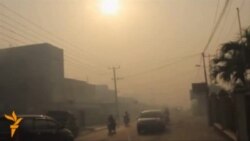One reason is that the world's biggest greenhouse-gas emitter is China, which is rapidly industrializing, and the second-biggest is the United States.
But this month's massive forest fires in Indonesia are putting the spotlight on another major source of atmospheric pollution -- burning forests for agricultural land.
The fires in Indonesia have created Southeast Asia's worst smog crisis for years, pushing haze levels in the neighboring city-state of Singapore to record levels last week.
The blankets of smoke traveling through the atmosphere also forced schools to shut in Malaysia's capital, Kuala Lumpur, on June 24.
It is not the first time vast clouds of smoke have poured into the sky from Indonesia.
In normal years, the archipelago state ranks among the world's top 10-15 largest greenhouse-gas emitters, even though its islands represent barely 1 percent of the world's landmass.
Clearing Land For Palm Oil
But in 2007 a World Bank report described Indonesia as the world's third-largest emitter. That took into account particularly massive fires in 1997 and 1998 that were exacerbated by unusually dry conditions.
Nego Tarigan, the director of Friends of the Earth Indonesia, says much of the smoke is coming from the clearing of forest land to make way for palm plantations.
"Palm oil in Indonesia already [accounts for] 11.9 million hectares of plantations. But the plan is for it to become 29 million hectares, bigger than [the land surface of] Belgium or the Netherlands," Tarigan says. "The land that still remains available is only in the forest, so the target of the companies is the forest land."
Indonesia is the world's top producer of palm oil, which is used in many everyday items from soap to biscuits and, more recently, biofuels.
The demand for biofuels has soared in Europe following a landmark EU decision in 2008 to move toward renewable energy. Beginning in 2020, each member country must obtain at least 10 percent of the energy it uses for land transportation from renewable sources, led by biofuels.
As the extent of deforestation in Indonesia became apparent, the EU negotiated a deal with Jakarta in 2011 to place a two-year moratorium on any new palm plantations. However, deforestation continues as the moratorium does not cover existing concessions and peatland areas.
Adam Harrison, with the international World Wildlife Fund, says that many of the fires today are being set by small farmers who hope to independently supply palm oil to the major plantations.
"Those sorts of fires are usually part of the smallholder agriculture system where slash-and-burn is used to clear land. Some of that is for food for the smallholder families themselves but a lot of it, increasingly, is to plant oil palm as smallholders and they then sell the fruit on to the oil palm companies," Harrison explains.
"So, although the companies themselves are not causing the fire, they are buying this fruit from these smallholders, so they are part of the supply chain which is where the fires are coming from."
With demand from industrialized countries high for biofuels, the clearing of Indonesia's forests -- and the massive air pollution that it produces -- only looks set to continue.
Official figures show more than half of Indonesia's rainforest -- the third largest in the world -- has been destroyed by logging, burning, and mining over the past few decades.
Scientists warn that many of Indonesia's species could be extinct in the wild within 20 to 30 years.
"This is the fastest, most comprehensive transformation of an entire landscape that has ever taken place anywhere in the world, including the Amazon," says Yuyun Indradi of Greenpeace Southeast Asia. "If it continues at this rate, all that will be left in 20 years is a few fragmented areas of natural forest surrounded by huge man-made plantations."











